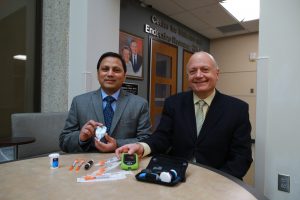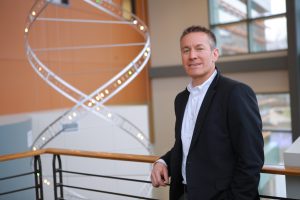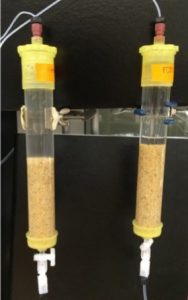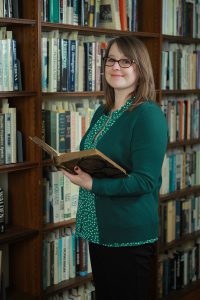Archive for February, 2019
UT operations to resume at noon; Classes to resume at 2 p.m.
Tuesday, February 12th, 2019Campus operations will resume at The University of Toledo at noon today, Tuesday, Feb. 12. Classes that start at 2 p.m. or later will resume their normal schedule.
All employees should report to work at noon and resume their normal schedule. Employees unable to report to work should contact their supervisor to request the appropriate leave approval.
The University had canceled morning classes due to severe weather. Conditions on campus continue to improve, however, caution is advised as icy conditions may cause slick spots on campus. Please report any concerns –– call 419.530.1000 on Main Campus and 419.383.5353 on Health Science Campus.
Any additional updates will be made available at utoledo.edu/weather.
A new mouse model from UT may unlock the secrets of treating Type I diabetes
Tuesday, February 12th, 2019Researchers at The University of Toledo have found a new way to replicate in lab mice the development and progression of Type I diabetes, a breakthrough that has the potential to reshape how the chronic disease is studied.
An estimated 1.25 million Americans are living with Type I diabetes. While the condition can be managed with insulin, finding a treatment or cure for the disease has been elusive — in part because scientists have not had a reliable animal model that mimics the full scope of human Type I diabetes.
“We see these patients every day. We see them come to the hospital, we see how they struggle,” said Dr. Juan Jaume, professor of medicine in UT’s College of Medicine and Life Sciences and senior author of the new invention. “Unfortunately, research has been held back because the scientific community didn’t have a good model to study the disease and its progression. Now we do. We have developed a mouse model that is a step forward toward finding a cure.”

Dr. Shahnawaz Imam, left, and Dr. Juan Jaume display an array of diabetes management tools. A new mouse model developed at the University of Toledo may open the door to research that finds new therapies.
The first peer-reviewed study using the UT-developed mouse model was published Feb. 7 in the natural sciences journal Scientific Reports.
In that study, Jaume, who is also chief of the Division of Endocrinology and director of UT’s Center for Diabetes and Endocrine Research, and co-collaborator Dr. Shahnawaz Imam, a senior researcher in the Departments of Medicine and an associate member of the Center for Diabetes and Endocrine Research, looked at how a certain protein can influence T-cells in the pancreas to delay the onset of diabetes.
While the study adds to the overall knowledge about diabetes, it is the mouse model that holds the real potential.
In the new model, mice spontaneously develop Type I diabetes and, importantly, the full range of complications experienced by diabetes patients. That allows study of the disease and its natural progression in a way not previously possible.
“Our model is showing exactly the same physiopathology that humans with diabetes suffer,” Imam said. “Our mice are getting eye problems, they are getting kidney problems and also neuropathy. That’s a very important part of this — they have the same human complications that all diabetes patients have, not just those with Type I.”
The laboratory mice were developed through a series of selective breeding experiments and genetic modification that included adding human genes to the mice.
A provisional patent on the Spontaneous Type I Diabetes Mouse Model was filed last year.
Type I diabetes, formerly known as juvenile diabetes, results from an autoimmune attack on cells in the pancreas that produce insulin. Without insulin, the body cannot process the sugars in food, leading to dangerously high blood sugar.
Though many species develop diabetes, Jaume said the process of Type I diabetes seems to be unique to humans. And while scientists have frequently used other specially bred mice, including what’s known as the non-obese diabetic mouse, to study diabetes and test treatments, those lab animals don’t mimic the exact human pathophysiology of the disease.
“The existing non-obese diabetic mouse model does not completely resemble the human condition,” Jaume said. “There are more than 125 different therapies that cure Type I diabetes in non-obese diabetic mice. Clinical trials were developed because of that model, but none have worked in humans. Everybody has been searching for a better model.”
Jaume and Imam have been working on their model for more than a decade. It is already showing research promise.
Using the same idea behind CAR T-cell therapy for cancer, in which certain immune system cells are taken from a patient and paired with an artificial receptor that once reintroduced into the body homes in on the tumor, the team is developing cellular therapies for diabetes that uses the mice’s regulatory cells to cool down the immune response.
The University has also filed a provisional patent on the treatment method, and Jaume and Imam will soon begin a more in-depth study of its effectiveness.
UT closed until noon Feb. 12
Tuesday, February 12th, 2019The University of Toledo will be closed until noon on Tuesday, Feb. 12, with essential employees only reporting to campus. University classes and operations are expected to resume at noon.
The University of Toledo Medical Center, as always, will remain open.
Any additional updates will be made available at utoledo.edu/weather.
UT scientists advance new technology to protect drinking water from Lake Erie algal toxins
Monday, February 11th, 2019Before the 2014 Toledo Water Crisis left half a million residents without safe drinking water for three days, Dr. Jason Huntley’s research at The University of Toledo focused on bacteria that cause pneumonia.
After the harmful algal bloom prompted the city of Toledo’s “Do Not Drink” advisory, the microbiologist expanded his research projects to target microcystin.

Dr. Jason Huntley
“I live here, and I have a young son,” said Huntley, associate professor in the UT Department of Medical Microbiology and Immunology in the College of Medicine and Life Sciences. “I don’t want toxins in the water, and I am committed to helping the water treatment plant protect the public.”
Huntley’s research lab recently made major progress in his mission to create a biofilter that uses naturally occurring Lake Erie bacteria to remove microcystin released by harmful algal blooms from drinking water, reducing or eliminating the use of chlorine and other chemicals.
“We’ve identified groups of bacteria in Lake Erie that can be used to naturally purify water. To our knowledge, these bacteria have not been previously used to fight harmful algal blooms in other parts of the world,” Huntley said.
The microbiologists successfully isolated bacteria from Lake Erie that degrade the microcystin toxin known as MC-LR – the most toxic, most common and most closely linked to liver cancer and other diseases – at a daily rate of up to 19 parts per billion (ppb).
Water analysts and toxicologists measure microcystin and other contaminants using the metric of ppb; one ppb is one part in 1 billion. These ppb numbers are important for human health because the U.S. Environmental Protection Agency recommends that young children not drink water containing more than 0.3 ppb of microcystin and adults not drink water containing more than 1.6 ppb of microcystin.
“The bacteria we’ve identified can degrade much more toxin than was reported in the 2014 water crisis,” Huntley said. “Based on recorded toxin levels in Lake Erie in recent years, these rates would be able to effectively remove microcystin from water supplies.”
None of the 13 microcystin-degrading bacterial isolates has been associated with human disease, so their use in future water-purifying biofilters is unlikely to be a public health concern. The identified bacteria include Flectobacillus major, Pseudomonas lutea, Agrobacterium albertimagni, Leadbetterella byssophila, Pseudomonas putida, Flectobacillus major, Pseudomonas hunanensis, Runella slithyformis, Porphyrobacter sp., Pseudomonas parafulva, Sphingobium yanoikuyae, Pseudomonas fluorescens and Sphingobium yanoikuyae.
The research is published in the February issue of the Journal of Great Lakes Research.
Researchers in Australia, China and other countries also have identified bacteria that can chew up and break down microcystin from algal blooms, however, Huntley said those specific types of bacteria were not found in any of his Lake Erie studies.

The lab-scale biofilters used during Dr. Huntley’s research are sand filters that contain biologically active bacteria that break down microcystin toxins.
Thirteen water samples used for the study were collected from visible algal blooms in the summers of 2014 and 2015 in the western basin of Lake Erie. The scientists added MC-LR to each water sample every three-to-four days for approximately four weeks, alongside a control group that did not receive additional MC-LR.
The lab used multiple approaches to confirm the microcystin degradation results, including mass spectrometry and the ELISA test, which is the standard method water treatment plant operators use to measure microcystin concentration during algal bloom season.
His lab is now in the process of identifying the enzymatic pathways the bacteria use to break down microcystin.
Currently, municipal water treatment plants remove or degrade microcystin using methods such as chlorination, ozonation, activated carbon adsorption and flocculation.
“Those techniques are not ideal because of high costs, limited removal efficiencies, and they lead to the production of harmful byproducts or hazardous waste,” Huntley said. “Biofilters are a cost-effective and safe alternative to the use of chemicals and other conventional water treatment practices.”
“We’re very excited about the research and the findings,” said Andrew McClure, administrator for the city of Toledo’s Collins Park Water Treatment Plant. “We’ve had preliminary talks with Dr. Huntley about ways we can implement it as a treatment technique in our plant’s process.”
Huntley’s team is developing and testing biofilters – water filters containing the specialized bacteria that degrade microcystin toxins from lake water as it flows through the filter. Huntley holds a provisional patent on this technology.
The research was supported by grants from the Ohio Department of Higher Education through the state’s Harmful Algal Bloom Research Initiative, which consists of 54 science teams at universities across the state seeking solutions to address toxic algae in Lake Erie.
“This is another great example of how Ohio Department of Higher Education-funded research is producing solutions that directly benefit Ohio EPA and those water treatment plant operators responsible for managing our drinking water,” said Dr. Chris Winslow, director of Ohio Sea Grant and Stone Laboratory at The Ohio State University.
Step into Black History Month: African-American dance show Feb. 11 at UT
Thursday, February 7th, 2019Step Afrika! will perform 7 p.m. Monday, Feb. 11 in the Thompson Student Union Auditorium at The University of Toledo.
The free, public event is sponsored by the Office of Multicultural Student Success and the Office of Diversity and Inclusion, and is part of the University’s celebration of Black History Month.
 The dance company is dedicated to the African-American tradition of stepping tours around the globe. Members have been taking the stage for 25 years and have multiple White House performances under their belts.
The dance company is dedicated to the African-American tradition of stepping tours around the globe. Members have been taking the stage for 25 years and have multiple White House performances under their belts.
“Attendees should expect an exciting performance,” David Young, UT director of Toledo Excel and special projects, said. “The experience is not only entertaining, but educational and interactive. Performers will pull audience members from the crowd to teach them steps and educate the audience on the history and culture of stepping.”
Stepping began as an African dance and has evolved into an African-American art form. It is primarily practiced by African-American sororities and fraternities.
History scholar awarded fellowship to write book about female plantation owner during American Revolution
Wednesday, February 6th, 2019A history scholar at The University of Toledo has been awarded a fellowship from the National Endowment for the Humanities (NEH) that will allow her to spend the 2019-20 academic year writing the history of Mary Willing Byrd, one of the few women who ran a large plantation in the early American South.
Dr. Ami Pflugrad-Jackisch, associate professor and chair of the UT Department of History, will use the fellowship to complete her book, “The World of Westover: Mary Willing Byrd, Gender, Slavery, and the Economics of Citizenship in Revolutionary Virginia.”

Dr. Ami Pflugrad-Jackisch, associate professor and chair of the UT Department of History
“I was shocked I had never heard of this woman when I first learned her name about 10 years ago, so I am excited by this opportunity to write an extensive study about her life,” Pflugrad-Jackisch said. “Mary Willing Byrd explodes a lot of myths about Southern white women during the revolutionary era. She’s not your typical Southern belle. Byrd believed that she was entitled to the same citizenship rights as white male property owners in the new republic, and she pushed to try and secure these rights for herself.”
Determined to track down and shine a light on Byrd’s story, Pflugrad-Jackisch spent nearly a decade unearthing a paper trail of letters, court cases, property records and tax records. Her archival quest took her to Virginia, Indiana, Pennsylvania, Rhode Island and Michigan.
“There is a stereotype that women slaveholders were more compassionate toward their slaves than men were, but women could be just as brutal as men could be,” Pflugrad-Jackisch said. “Mary Willing Byrd is a fascinating example. A wealthy widow, she ran the Westover plantation for 37 years and was able to pay off the estate’s enormous debts left by her late husband William Byrd III by using slave labor to make her plantation profitable.”
Pflugrad-Jackisch received one of 84 fellowships announced by the NEH totaling $4.6 million. The NEH, an independent federal agency created in 1965, works to serve and strengthen the country and convey the lessons of history by awarding grants for top-rated proposals examined by panels of independent, external reviewers.
“These new NEH grants represent the humanities at its most vital and creative,” Jon Parrish Peede, NEH chairman, said. “These projects will shed new light on age-old questions, safeguard our cultural heritage, and expand educational opportunities in classrooms nationwide.”
“We are extremely proud of Dr. Pflugrad-Jackisch’s award. This prestigious national fellowship was awarded to only 7 percent of the applicants,” Charlene Gilbert, dean of the UT College of Arts and Letters, said. “Her success is a testament to her brilliant scholarship and dedication to her research.”
In her manuscript, Pflugrad-Jackisch makes use of Byrd’s correspondence to Thomas Jefferson and high-ranking military officials during the Revolutionary War, including the Marquis de Lafayette. These letters demand the return of escaped slaves and compensation for property lost when the British army under the command of the traitor Benedict Arnold raided her plantation along the James River, damaging all of her farming equipment.
“This research has been quite tedious because Byrd’s information is often catalogued in archives under the names of men, not her own name, or placed unlabeled in the ‘miscellaneous’ folders. She has a letter in the collection of Thomas Jefferson’s papers, but you have to know it is there to go look for it,” Pflugrad-Jackisch said. “You have to physically go and dig through boxes of male relatives’ business records because Byrd is unlisted. You wouldn’t know they were there. I found 33 of Byrd’s letters in a collection marked ‘Willing Family Business Records’ that only listed the names of her brothers and nephews.”
In her role as manager of Westover plantation, Byrd directed the labor of more than 100 slaves; supervised the plantation’s overseers; sold wheat, barley, corn and tobacco crops; and fended off her late husband’s creditors in court. Her interactions with the state, military and market were out of the ordinary for a woman during that tumultuous time of upheaval.
“Byrd’s world provides scaffolding and a framework for the broader complexities of this era, bundling together the challenges of establishing credit, political loyalty, motherhood and slave management, themes that historians usually explore separately,” Pflugrad-Jackisch said. “This project examines how the remaking of Virginia’s legal, economic and cultural institutions during and after the war laid the foundation for the construction of gendered and racial hierarchies that would come to define women’s citizenship by the beginning of the 19th century.”
Pflugrad-Jackisch’s first book, “Brothers of a Vow: Secret Fraternal Organizations and the Transformation of White Male Culture in Antebellum Virginia,” was published in 2010 by the University of Georgia Press.
UT Confucius Institute to welcome Year of the Pig Feb. 6
Tuesday, February 5th, 2019It’s swine time: Celebrate the Year of the Pig at the Chinese New Year Spring Festival Carnival Wednesday, Feb. 6.
The free, public event at The University of Toledo will take place from 11 a.m. to 2 p.m. in the Thompson Student Union Auditorium.
 “The Chinese New Year Festival celebrates the beginning of a new year on the lunar calendar,” Xinren Yu, international program coordinator in the UT Confucius Institute, said. “This is the Year of the Pig. People who are born in this year have a beautiful personality and are blessed with good fortune in life.”
“The Chinese New Year Festival celebrates the beginning of a new year on the lunar calendar,” Xinren Yu, international program coordinator in the UT Confucius Institute, said. “This is the Year of the Pig. People who are born in this year have a beautiful personality and are blessed with good fortune in life.”
Those who attend the event will have a chance to take part in more than a dozen cultural activities, including Chinese paper cutting, paper folding, calligraphy, ring toss and lucky bracelet making.
Several games such as ring toss and ping-pong also will be available to play.
“Participants will need to get involved to collect stamps for free meals and redeem prizes,” Yu said.
The Chinese New Year is the most important holiday for the Chinese and is a time for family reunions, according to Yu. Many of the traditional rites and activities during the Chinese New Year are meant to bring good luck to the household and long life to the family.
The Confucius Institute serves northwest Ohio by providing education in Chinese language and culture. It also offers opportunities for cultural exchange between China and the United States.
UT research looks at fiber as a trigger and cure for inflammatory bowel disease
Tuesday, February 5th, 2019New research from The University of Toledo’s College of Medicine and Life Sciences may give patients suffering from inflammatory bowel disease a better roadmap for managing their symptoms by changing the type of fiber they eat during flare-ups.
Because there’s no cure for the chronic condition, patients living with Crohn’s disease and ulcerative colitis — the two most common types of IBD — often rely on anti-inflammatory or immunosuppressive drugs and careful diet planning to manage their symptoms, said Dr. Matam Vijay-Kumar, the senior author on the study and director of the UT Microbiome Consortium and associate professor in the UT Department of Physiology and Pharmacology.
But even that can seem like guesswork.
“IBD can be a debilitating condition and its prevalence is on the rise. For IBD patients, there has been a puzzling question of why they report poor tolerance to certain types of dietary fibers,” said Dr. Vishal Singh, a Crohn’s and Colitis Foundation Fellow mentored by Vijay-Kumar at UT.

Dr. Vishal Singh, a Crohn’s and Colitis Foundation Fellow at UT, holds apples and oranges, common natural sources of pectin.
“For healthy people, dietary fibers are good,” he said. “But when it comes to the IBD patients, not all natural fibers are created equal, thus their metabolism is distinct. We wanted to understand why.”
In a study published last month in the gastroenterology journal Gut, a team of UT researchers demonstrated a diet rich in pectin or pectin-derived fibers may be a better alternative to the prevailing dietary fiber guidelines aimed at helping patients improve their IBD symptoms.
The study also confirmed that inulin and inulin-like fiber exacerbated colitis in lab mice.
Inulin and pectin are two of the most common refined fibers added to processed foods as a way to add texture and boost their health appeal. Both are indigestible soluble fibers, Vijay-Kumar said, but they require different bacterial enzymes to be broken down in the gut into short-chain fatty acids.
“Many patients try to avoid fiber,” said Singh, the study’s first author. “However, the research shows it’s not about reducing fiber in general but getting the right kind into your system.”
Singh and his fellow researchers said the finding could assist patients in developing a better diet for managing or preventing flare-ups.
“Following strict dietary guidelines is not new for IBD patients. Physicians often recommend patients limit or avoid a group of foods that contain fermentable carbohydrates, commonly known as the low-FODMAP diet,” Vijay-Kumar said. “Pectin is not included in that diet, but our research shows it brings a clear benefit.”

Dr. Matam Vijay-Kumar
The study was supported by the Crohn’s and Colitis Foundation and the National Cancer Institute of the National Institutes of Health.
In the study, researchers examined the role played by bacteria that naturally reside in our guts. They demonstrated that inulin promoted accelerated growth of one particular harmful bacterial strain, while pectin did not.
They also found that a brief period of fasting may boost our body’s production of a physiological inflammation inhibitor that can protect against the inflammatory reaction caused by the gut bacteria processing inulin.
“For me, this study connects very well from bench to bedside,” Singh said. “If an IBD patient is noticing complications after eating some type of food, they can look to see if is rich in inulin or inulin-type fibers. If it is, they can switch to foods enriched with pectin.”
Pectin is found naturally in a variety of foods, including apples. It also can be derived from other natural sources, such as orange peels, and used as a food additive.
Though the study looked only at pectin and inulin, the team hopes to conduct similar studies on a wide variety of dietary fibers present in processed foods with the goal of learning more about how different types of fiber cause or reduce colonic inflammation.
First class of Toledo Fire Department paramedics among new inductees to UT Emergency Medicine Wall of Honor
Monday, February 4th, 2019The University of Toledo will add 14 names to the Emergency Medicine Wall of Honor at the eighth annual induction ceremony on Tuesday, Feb. 5, including the first group of Toledo firefighters to be certified as paramedics.
This year’s other inductees are a long-time clinical nursing educator and an emergency medical services outreach education coordinator.
The ceremony will begin at noon in Collier Building Room 1000B on Health Science Campus with a welcome from UT President Sharon L. Gaber. A reception with light refreshments begins at 11:30 a.m.
Dr. Kristopher Brickman, professor and senior associate dean for innovation in the College of Medicine and Life Sciences, and Dr. Christopher Cooper, executive vice president for clinical affairs and dean of the College of Medicine and Life Sciences, also are scheduled to give remarks.
“This award recognizes people who have been instrumental in developing and defining what emergency care is in our region,” Brickman said. “We want to honor some of our unsung heroes of emergency medicine who have helped save lives and made a real difference in our community.”
The Emergency Medicine Wall of Honor, made possible through funding from IPI Insta-Plak Inc. and The Blade, was established in 2011 to celebrate the achievements of those who are committed to service within the emergency medicine community.
Each year, nominations are submitted by a committee of community stakeholders and reviewed by a multidisciplinary selection committee. This year’s group is larger because of the inclusion of all 12 members of the Toledo Fire Department’s first paramedic class.
“Those firefighters were a unique group of people who basically were out there doing something that nobody else had done before,” Brickman said. “For our region they were the pioneers.”
The honorees this year are:
- Patricia Rice Yancy, registered nurse. Yancy, who earned master’s degrees in education and public health from UT after completing a bachelor’s degree in nursing from Mary Manse College, initiated several training courses for nurses, including critical care and flight nurse programs. She has been instrumental in training thousands of nurses, doctors and other pre-hospital employees throughout her career. She recently retired from Lourdes University.
- Patricia Ann Ambrose, paramedic. Ambrose was the EMS outreach education coordinator for Mercy Health St. Vincent Medical Center Life Flight and Mobile Life. She also was a lifelong EMS and life support educator, including playing an integral role in the paramedic education program and the former Medical University of Ohio. Ambrose died in 2018.
- Members of the Toledo Fire Department paramedic class of 1974, who are: William Brown, Michael Condon, James Dugan, David Hilton*, Alan Janney, Paul Johnston, Renzo Meraldo, James Markland, Ralph Mungons, Samuel Reynolds, Barney Rouster* and Daniel Thedford. The 1974 class was the first group of firefighters to train as paramedics in Toledo as part of a joint project with the then Medical College of Ohio. They were pioneers in their field and are uniquely responsible for building and advancing emergency medical services in Lucas County. *Posthumous recognition.
A plaque for each honoree will be added to the wall, located in the Emergency Department of The University of Toledo Medical Center, near the ambulance entrance.
Business mogul to speak at UT for Black History Month
Monday, February 4th, 2019Dr. William F. Pickard will share his story of being the first person in his family to graduate from college and working to become one of the top businessmen in the country when he visits The University of Toledo as part of UT’s celebration of Black History Month.
He will speak 7 p.m. Tuesday, Feb. 26 in Doermann Theatre.

Dr. William F. Pickard
Pickard is chair of Global Automotive Alliance, a co-managing partner of MGM Grand Detroit Casino, CEO of Bearwood Management Co., and co-owner of five newspapers.
“We are excited to have Dr. Pickard as our featured speaker this year,” David Young, UT director of Toledo Excel and Special Projects, said. “He will talk about achieving success despite the odds.”
Pickard’s career started with a McDonald’s franchise in Detroit. In 1989, he founded an automotive manufacturing company, which became Global Automotive Alliance. The holding company for some half dozen businesses has about 1,600 workers and approximately $500 million in sales. One of the nation’s leading minority-owned companies, Global Automotive Alliance supplies plastic parts to the top three automakers in the United States.
During his more than 40-year career, Pickard has mentored African-American business owners and published a book, “Millionaire Moves: Seven Proven Principles of Entrepreneurship.”
“I fully embrace the mantra: ‘Each one, reach one, teach one.’ These words get me fired up,” he wrote in the introduction of his 2017 book. “They also explain the purpose of this book. This is my way of saying that whatever I’ve done, you can do it, too.”
The entrepreneur and philanthropist shares his leadership skills on the board of the National Urban League and as a member of the Detroit branch of the National Association for the Advancement of Colored People. In 1982, President Ronald Reagan appointed Pickard to be the first chair of the African Development Foundation, and President George Bush tapped him to serve on the National Advisory Committee on Trade Policy Negotiations in 1990.
Pickard received a bachelor’s degree from Western Michigan University, a master’s degree from the University of Michigan, and a doctorate from Ohio State University.
 In addition to Pickard’s talk, the University will celebrate this year’s theme, “Embracing Our Power — Honoring Our History,” with several events during Black History Month. Listed by date, events will include:
In addition to Pickard’s talk, the University will celebrate this year’s theme, “Embracing Our Power — Honoring Our History,” with several events during Black History Month. Listed by date, events will include:
- Tuesday, Feb. 5 — Black Student Union Comedy Show, 7 p.m., Thompson Student Union Ingman Room.
- Wednesday, Feb. 6 — Jerome Jenkins, former basketball coach at California State University at Sacramento, will give a talk, “The War Within,” at 6:30 p.m. in Thompson Student Union Room 2592.
- Thursday, Feb. 7 — Black History Month Film Series: “Moonlight,” 7:30 p.m., Center for Performing Arts Room 1039.
- Monday, Feb. 11 — Step Afrika! will perform at 7 p.m. in the Thompson Student Union Auditorium. The dance company dedicated to the African-American tradition of stepping tours around the globe.
- Thursday, Feb. 14 — Black History Month Film Series: “Creed,” 7:30 p.m., Center for Performing Arts Room 1039.
- Friday, Feb. 15 — Dr. Derek Alderman, professor of geography at the University of Tennessee, will give a talk titled “The Maps Behind the Movement: African-American Freedom Struggles as Geographical Work” at 2:30 p.m. in Snyder Memorial Building Room 2110.
- Thursday, Feb. 21 — Black History Month Film Series: “Pariah,” 7:30 p.m., Center for Performing Arts Room 1039.
- Friday, Feb. 22 — Black Student Union Fashion Show, 6 p.m., Thompson Student Union Auditorium. Ticket prices to be announced.
- Monday, Feb. 25 — “Black GirlZ Rock,” 6 p.m., Thompson Student Union Ingman Room. The National Pan-Hellenic Council will honor women on campus who have made an impact on UT students.
- Thursday, Feb. 28 — Black History Month Film Series: “Get Out,” 7:30 p.m., Center for Performing Arts Room 1039.
All events are free unless otherwise noted.

